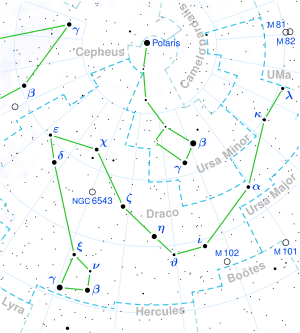G 240-72
| Observation data Epoch J2000[1] Equinox J2000[1] | |
|---|---|
| Constellation | Draco |
| Right ascension | 17h 48m 08.17s[1] |
| Declination | +70° 52′ 35.3″[1] |
| Apparent magnitude (V) | 14.15[2] |
| Characteristics | |
| Spectral type | DQP9.0[2] |
| Apparent magnitude (B) | 14.55[1] |
| Apparent magnitude (V) | 14.15[1] |
| Apparent magnitude (R) | 13.5[1] |
| Apparent magnitude (I) | 13.1[1] |
| Apparent magnitude (J) | 12.709 ± 0.021[1] |
| Apparent magnitude (H) | 12.528 ± 0.023[1] |
| Apparent magnitude (K) | 12.507 ± 0.023[1] |
| Astrometry | |
| Proper motion (μ) | RA: -1261[3] mas/yr Dec.: 1112[3] mas/yr |
| Parallax (π) | 160.9952 ± 0.0119 mas[4] |
| Distance | 20.259 ± 0.001 ly (6.2114 ± 0.0005 pc) |
| Absolute magnitude (MV) | 15.23[2][5][note 1] |
| Details | |
| Mass | 0.81 ± 0.01[2] M☉ |
| Radius | 0.00984[2][note 2] R☉ |
| Luminosity | 0.000085[6] L☉ |
| Surface gravity (log g) | 8.36 ± 0.02[2] cgs |
| Temperature | 5590 ± 90[2] K |
| Rotation | >100 years[7] |
| Age | 5.69[note 3][3] Gyr |
| Other designations | |
| Database references | |
| SIMBAD | data |
Location of G 240-72 in the constellation Draco | |
G 240-72 (or WD 1748+708, or LHS 455, or GJ 1221) is a nearby degenerate star (white dwarf) of spectral class DQP9.0,[2] located in constellation Draco.
Distance[edit]
G 240-72 is the seventh closest white dwarf (after Sirius B, Procyon B, van Maanen's star, Gliese 440, 40 Eridani B and Stein 2051 B). Its trigonometric parallax is 0.1647 ± 0.0024 arcsec,[5] corresponding to a distance 6.07 ± 0.09 pc, or 19.80+0.29
−0.28 ly.
Properties[edit]
G 240-72 has mass 0.81 Solar masses[2] and surface gravity 108.36 (2.29 · 108) cm·s−2,[2] or approximately 234 000 of Earth's, corresponding to a radius 6850 km, or 107% of Earth's.
This white dwarf has relatively low temperature 5590 K[2] (slightly cooler than the Sun), and old cooling age, i. e. age as degenerate star (not counting duration of previous existence as main sequence star and as giant star) 5.69 Gyr.[3] It has a white appearance, due to its similar temperature to the Sun. It has a pure helium atmosphere and rotates very slowly, with period of possibly over 100 years.[7]
References[edit]
- ^ a b c d e f g h i j k l m n o "GJ 1221 -- White Dwarf". Centre de Données astronomiques de Strasbourg. Retrieved 2011-10-23.
- ^ a b c d e f g h i j k l m Holberg, J. B.; Sion; Oswalt; McCook; Foran; Subasavage (2008). "A New Look at the Local White Dwarf Population". The Astronomical Journal. 135 (4): 1225–1238. Bibcode:2008AJ....135.1225H. doi:10.1088/0004-6256/135/4/1225. S2CID 122855486.
- ^ a b c d e Sion, Edward M.; Holberg; Oswalt; McCook; Wasatonic (2009). "The White Dwarfs within 20 Parsecs of the Sun: Kinematics and Statistics". The Astronomical Journal. 138 (6): 1681–1689. arXiv:0910.1288. Bibcode:2009AJ....138.1681S. doi:10.1088/0004-6256/138/6/1681. S2CID 119284418.
- ^ Brown, A. G. A.; et al. (Gaia collaboration) (2021). "Gaia Early Data Release 3: Summary of the contents and survey properties". Astronomy & Astrophysics. 649: A1. arXiv:2012.01533. Bibcode:2021A&A...649A...1G. doi:10.1051/0004-6361/202039657. S2CID 227254300. (Erratum: doi:10.1051/0004-6361/202039657e). Gaia EDR3 record for this source at VizieR.
- ^ a b c Van Altena W. F.; Lee J. T.; Hoffleit E. D. (1995). "GCTP 2835.01". The General Catalogue of Trigonometric Stellar Parallaxes (Fourth ed.).
- ^ Giammichele, N.; Bergeron, P.; Dufour, P. (April 2012), "Know Your Neighborhood: A Detailed Model Atmosphere Analysis of Nearby White Dwarfs", The Astrophysical Journal Supplement, 199 (2): 29, arXiv:1202.5581, Bibcode:2012ApJS..199...29G, doi:10.1088/0067-0049/199/2/29, S2CID 118304737.
- ^ a b MEASURING THE ROTATIONAL PERIODS OF ISOLATED MAGNETIC WHITE DWARFS
Notes[edit]
External links[edit]

